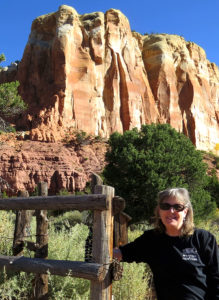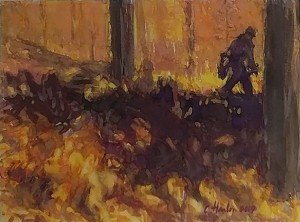Dear Artist,
Notan is a Japanese word that means “lightness-darkness.” It represents one of the basic principles that help compositions stick to the wall. Notan has nothing to do with local or chosen colour. It’s the ability to see things in terms of black and white, and to consequently build strength in imagery. When compositions work in black and white — they work.
Whether they put a name to it or not, artists in all cultures have long recognized the value of notan. Devices have been invented to look for and find it. The “Claude glass” is a convex, black glass used to reflect a landscape in a reduced size with muted colours and less detail. The French painter Claude Lorraine (1600-1683) is thought to have invented it. While the odd one is still seen among “plein air” painters, the more common approach is to view work with half-closed eyes — or to get way back. Another system is to view art and subjects through generally blue or green camera filters or gels. But more than anything notan is a learned skill. For those of us who struggle daily at the painting game — the enemy is “wishy-washy” — the desired object is to yin and yang with the viewer’s sensibilities. In the words of Junichiro Tanizaki, “Find beauty not only in the thing itself but in the pattern of the shadows, the light and dark which that thing provides.”
There are two types of notan — planned notan and developmental notan. Planned notan is often figured out in a preparatory sketch, or is “ready made” in the subject matter. Developmental notan is where you find notan — indeed you make notan — as you go along. Notan is also a matter of degree — it can be a strong, interactive pattern with negative and positive, even an eye-fooling optical illusion. In abstract work, the job of finding notan can be the main joy and source of magic. In more realistic work it can be a skittish but nevertheless satisfying pattern discovered and built during the process. Tuned-in artists find themselves saying, “This is good notan.” An exercise that never hurt anybody is to simply plan and calculate good notan into a work — then make sure it stays put.
Best Regards,
Robert
PS: “Notan is a synthetic arrangement of dark and light that creates an impression of beauty, regardless of either the colors used or of the subject matter. A strong notan design is therefore the key to a strong painting. Without it, both color and line fail to reach their full impact. Many of the most powerful paintings have the simplest value structures. That is to say, they only use two, three, or four major values.” (Barry John Raybould)
Esoterica: Very often the quality of a work can slip because artists simply fail to work things out in the best order. A carefully drawn and even beautifully prepared work may, for example, have poor notan. Never forget that drawing and line can be the enemies of pattern. “Think pattern first, then drawing, then color. The character of your painting is resolved in the pattern.” (Edgar Whitney)
This letter was originally published as “Notan” on March 30, 2004.
Download the new audio book, The Letters: Vol. 1 and 2, narrated by Dave Genn, here. Proceeds of sales contribute to the production of The Painter’s Keys.
“The discipline endured is the mastery achieved.” (Edgar A. Whitney)
Featured Workshop
 Ghost Ranch, New Mexico, Darla Bostick, (June and October) workshops
Ghost Ranch, New Mexico, Darla Bostick, (June and October) workshops
Relax, enjoy, create!
Photography/watercolors/acrylics/mixed media. Group activity room (floor to ceiling vista). Ghost Ranch Lodging/meals provided. See why Georgia O’Keeffe loved Ghost Ranch. Each workshop/retreat is different. The June workshop leans heavier on all kinds of materials –textiles and dye, printing, painting, pouring and more! The October workshop combines the media of photography, watercolor, ink, acrylic and more — using watercolor paper, clayboard, etc!
Daily demos, slide presentations, door prizes and optional happy hour. The website shows how I work from Ghost Ranch scenes to finished paintings. www.darlabostick.com
Featured Artist
Christine Hanlon, whose work has been compared to that of Edward Hopper, creates ‘urban landscapes which quietly exude atmosphere.’









10 Comments
It is interesting to apply any of the compositional criteria to painting that seemingly tries to not wrestle with the traditional “story telling” intentions. Pop Art or contemporary approaches perhaps. The good ones still get it. The eye has to be kept within the boxes we deal with, even if tossing it out is part of the plan. I like the historical reference in this post.
This seems like another way to talk about value and contrast. Thanks for the thought-provoking message.
Thank you for this very good article! I will be putting more focus on notan.
excellent to keep in mind indeed for most in planning. Thank you for making it so! Love all your posts am always excited to open them .
In this area (Washington DC) I have been taught to use a reg gel to look for lights and darks; there is also an app for cellphones “ValueViewer” that allows you to take a photo, then reduce the image to black and white (called not an) or shades of gray.
My question is, if one looks through a red (or blue or green) filter, won’t the color of the filter affect the values one sees?
Make that a red gell, please.
I would e to receive these on Facebook. How do I sign,up.
Excellent advice on light and dark – the planned ones and the happy accident ones , tend to both work out well – tks for another informative piece
mary http://www.pixi-art.com
When I do on-the-spot caricatures of suitably savvy customers, I sometimes joke with them and say I follow the Japanese Notan system – some blacks some whites but not fifty shades of grey!
What a wonderful sense of humour Desmond! I loved it made me laugh & smile. Thanks so clever!